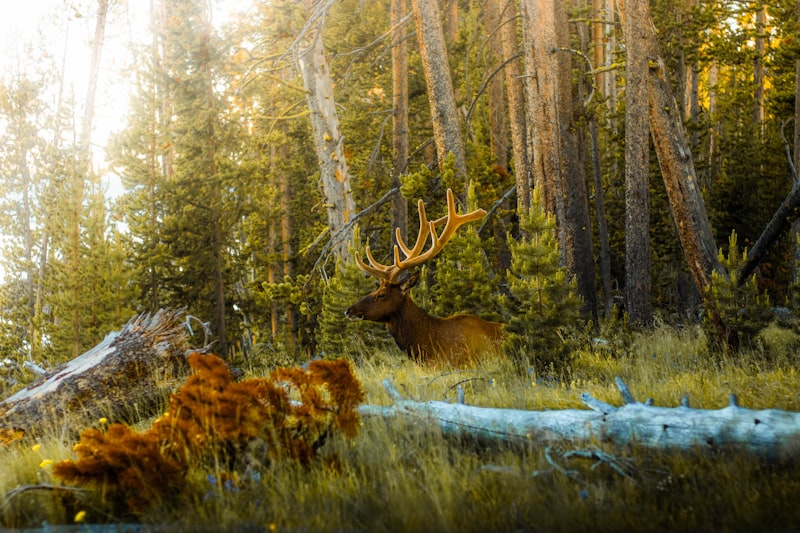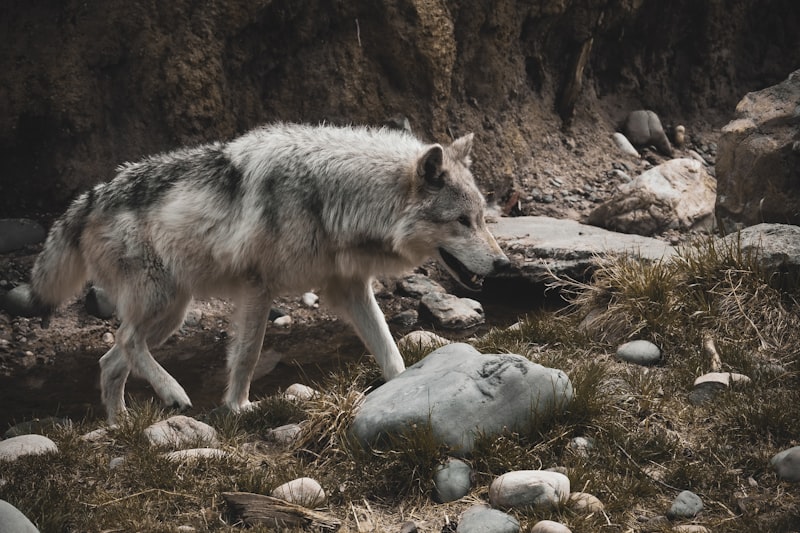Wolves in Yellowstone National Park play a pivotal role in maintaining the delicate balance of the ecosystem. Once on the brink of extinction, their reintroduction in 1995 sparked a remarkable ecological recovery, often termed as a “trophic cascade.” This phenomenon refers to the ripple effect wolves have on their environment, starting from the top of the food chain and influencing every level below.
At the apex, wolves primarily prey on elk, which had previously overgrazed certain areas of the park. Their presence now regulates elk populations, preventing overbrowsing and allowing vegetation to regenerate. This, in turn, benefits other wildlife such as beavers, birds, and even fish, as healthier vegetation stabilizes riverbanks and improves water quality.
Moreover, wolves’ hunting patterns have reshaped the behavior of elk, keeping them more alert and mobile. This has led to less browsing pressure on young trees and shrubs, encouraging forest regeneration. In essence, wolves act as ecosystem engineers, sculpting habitats that benefit a diversity of species.
Beyond their ecological impact, wolves have captured the public imagination, becoming a symbol of wilderness and resilience. Their howls echo through Yellowstone’s valleys, reminding visitors of the park’s natural rhythms and wild character. Observing wolves in their natural habitat provides a rare glimpse into predator-prey dynamics and the intricate web of life.
As Yellowstone continues to evolve, the role of wolves remains crucial. Their presence serves as a barometer for the park’s health and underscores the importance of conservation efforts. Understanding and protecting these apex predators ensures that future generations can witness firsthand the awe-inspiring beauty and ecological richness of Yellowstone National Park.
Balancing Act: How Wolves Are Restoring Ecosystem Health in Yellowstone
The reintroduction of wolves into Yellowstone in the 1990s marked a pivotal moment in conservation history. Their absence had allowed prey populations, like elk, to surge unchecked, leading to overgrazing of young trees and shrubs along riverbanks. This unchecked grazing destabilized riverbanks, eroded soils, and altered the course of streams. The ecosystem was out of balance, and the effects were far-reaching.
With the return of the wolf, however, a delicate balance has been restored. Wolves prey primarily on elk, thinning their numbers and altering their behavior. This has led to a phenomenon known as trophic cascade, where the presence of a top predator affects the entire food web. As elk move more cautiously to avoid wolf predation, vegetation once heavily browsed has begun to regenerate. Young aspen, willow, and cottonwood trees are now thriving along waterways, stabilizing banks and providing habitat for songbirds and beavers.
Moreover, the return of vegetation has attracted new species. Birds nest in the regenerated forests, insects flourish in the new growth, and beavers build dams, creating ponds that support even more biodiversity. The landscape itself is transforming, with more varied plant life supporting a broader array of herbivores, insects, and birds.
The story of Yellowstone’s wolves illustrates the intricate connections within ecosystems. It’s a tale of how the presence of one species can ripple through an entire landscape, restoring harmony where imbalance once reigned. As we continue to study and learn from these natural processes, we gain a deeper appreciation for the interconnectedness of life and the importance of preserving ecological integrity.
Yellowstone’s Ecological Engineers: The Impact of Wolves on Biodiversity
When wolves were reintroduced to Yellowstone in the 1990s after a long absence, their impact was profound and far-reaching. Initially, their return sparked controversy, but over time, scientists have observed fascinating changes in the park’s ecosystem. Wolves are apex predators, meaning they sit atop the food chain, regulating the populations of other species such as elk and deer. By preying on these herbivores, wolves prevent overgrazing in certain areas, allowing vegetation to regenerate and thrive.
This phenomenon, known as trophic cascades, has had cascading effects throughout Yellowstone. As the elk population adjusted to the presence of wolves by avoiding open areas and browsing less intensively, young trees and shrubs previously overgrazed began to recover. This, in turn, attracted more songbirds and beavers, which rely on the vegetation for habitat and food.
Moreover, wolves indirectly benefit other species by keeping their prey populations healthy. A diverse array of scavengers, from grizzly bears to bald eagles, feed on carcasses left behind by wolves, ensuring that nothing goes to waste in nature’s cycle. This process not only sustains these scavenger populations but also enriches the soil as nutrients from decomposing carcasses are absorbed by the land.
In essence, the return of wolves to Yellowstone exemplifies nature’s resilience and interconnectedness. Their presence has revitalized plant communities, supported a variety of wildlife, and contributed to the overall health of the park’s ecosystem. As visitors marvel at Yellowstone’s breathtaking landscapes, they are witnessing firsthand the profound impact of wolves as ecological engineers, shaping biodiversity in ways both visible and hidden.
From Extinction to Ecological Savior: Wolves’ Return to Yellowstone
Yellowstone National Park, a sprawling wilderness renowned for its geothermal wonders and diverse wildlife, has witnessed a remarkable ecological transformation since the reintroduction of wolves in 1995. Once on the brink of local extinction due to predator control measures in the early 20th century, wolves have now become pivotal in restoring the park’s natural balance.
Before their return, Yellowstone’s ecosystem faced profound challenges. Elk populations soared unchecked, overgrazing willow and aspen trees along streams, which disrupted the habitat of numerous other species. Without natural predators like wolves, the delicate web of life in the park began to unravel.
The reintroduction of wolves sparked a cascade of ecological benefits. As apex predators, wolves primarily prey on elk, leading to a reduction in their numbers and altering their grazing patterns. This, in turn, allowed vegetation to regenerate along riverbanks, benefiting beavers, songbirds, and fish. The revival of willows and aspens provided more habitat for birds and insects, enriching biodiversity across the park.
Moreover, the presence of wolves has even impacted the physical geography of Yellowstone. Their predatory behavior has influenced the movement of elk herds, preventing them from lingering in one area and allowing plant communities to recover. This phenomenon is often referred to as a trophic cascade, where changes at the top of the food chain ripple throughout the entire ecosystem.
Beyond ecological benefits, the return of wolves has captivated the public imagination, becoming a symbol of successful wildlife conservation efforts. It demonstrates the resilience of nature when given the opportunity to rebound from human-induced disruptions.
The reintroduction of wolves to Yellowstone National Park has not only revitalized the landscape but also serves as a powerful testament to the interconnectedness of species within an ecosystem. As wolves continue to thrive in their natural habitat, their story reminds us of the profound impact that apex predators can have in restoring ecological harmony.
Predators of Change: Wolves’ Influence on Elk Population Dynamics
Imagine a dense forest where elk graze peacefully, their numbers growing steadily due to abundant food sources. Enter the wolves, apex predators that bring a new dimension to this serene landscape. Their predatory prowess isn’t just about the chase; it’s about the balance they bring. Wolves target the weaker members of the elk herds, the old and infirm, thereby strengthening the gene pool of the elk population by allowing the fittest to survive and reproduce.
This selective predation isn’t just a matter of survival of the fittest; it’s a natural check on elk overpopulation. Without wolves, elk herds can swell beyond the carrying capacity of their environment, leading to overgrazing and habitat degradation. The wolves’ presence keeps elk numbers in check, ensuring a healthier balance between prey and vegetation.
Moreover, the indirect effects of wolf predation are equally profound. As elk adjust their behaviors to avoid becoming prey, they alter their grazing patterns, avoiding certain areas or feeding at different times. This behavioral shift can lead to vegetation recovery in previously overgrazed areas, benefiting a myriad of other species dependent on these habitats.
In essence, the wolves’ influence on elk population dynamics goes beyond mere numbers. It shapes the very fabric of the ecosystem, promoting biodiversity and resilience. Their presence sparks a cycle of renewal where prey and predator dance in an ancient rhythm, each fulfilling a crucial role in the tapestry of nature’s balance.
As we marvel at the intricate interplay between wolves and elk, we are reminded of nature’s wisdom—a delicate equilibrium where even the fiercest predators play a vital role in nurturing the diversity and vitality of our natural world.
Beyond the Hunt: Wolves’ Surprising Impact on Plant Communities
One of the most remarkable aspects of wolves’ impact on plant communities is their regulation of herbivore populations. By preying on herbivores like deer and elk, wolves manage their numbers, preventing overgrazing in delicate habitats. This moderation allows vegetation to flourish, benefiting a diverse array of plant species that might otherwise be consumed beyond sustainability.
Moreover, the presence of wolves triggers a cascade effect known as trophic cascades. When wolves keep herbivore populations in check, vegetation density and diversity increase. This abundance then supports a broader spectrum of wildlife, from insects to birds, fostering a healthier and more resilient ecosystem.
In areas where wolves have been reintroduced, researchers have observed surprising recoveries of native plant species. For instance, in Yellowstone National Park, the reintroduction of wolves led to a decrease in elk browsing pressure on aspen and willow trees. This reduction allowed these tree species to regenerate, providing habitat and food for numerous other species, including songbirds and beavers.

Furthermore, the fear factor associated with wolves, known as the “landscape of fear,” influences herbivore behavior. This fear alters where and when herbivores feed, which in turn affects plant growth patterns. Areas with heightened wolf presence may see less herbivory near wolf dens or in open spaces, leading to varied plant growth and community structure across the landscape.
In essence, wolves’ impact on plant communities goes well beyond their role as predators. Their presence shapes ecosystems in intricate ways, fostering biodiversity and resilience across the natural world. Understanding these dynamics underscores the importance of apex predators in maintaining healthy, balanced environments where both flora and fauna can thrive.
Cascading Effects: Wolves, Rivers, and the Ecology of Yellowstone

Before the wolves’ return, elk populations had surged, unchecked by natural predators. They grazed heavily on willows and other vegetation along the riverbanks, leading to erosion and reduced biodiversity. The once-lush riparian zones were fading, impacting fish, birds, and beavers dependent on these habitats.
With the wolves back in the picture, their predatory presence altered elk behavior. Fearful of becoming prey, elk avoided lingering in open areas and riverbanks where visibility was poor. This behavioral shift, termed the “landscape of fear,” allowed willows and other plants to regenerate.
As these plants rebounded, the riparian ecosystems flourished once more. Stable riverbanks meant less erosion, cleaner water, and enhanced habitats for fish like trout and species like songbirds that rely on healthy river corridors. Beavers returned too, building dams that created ponds, which further enriched biodiversity.
The resurgence of vegetation also attracted other herbivores like deer and moose, diversifying the prey base for wolves and providing more opportunities for scavengers like bald eagles and ravens. The entire ecosystem, from soil microbes to apex predators, experienced a revitalization, illustrating the intricate connections within nature.
This ecological marvel underscores the profound impact of keystone species like wolves on their surroundings. It challenges our understanding of conservation and reinforces the importance of preserving biodiversity for future generations. Yellowstone’s story of cascading effects reminds us that every creature, from the majestic wolf to the smallest insect, plays a vital role in maintaining Earth’s delicate balance.
Frequently Asked Questions
How did the reintroduction of wolves affect Yellowstone’s biodiversity?
Learn how the reintroduction of wolves revitalized Yellowstone’s biodiversity, balancing ecosystems and promoting species diversity.
How have wolves impacted the landscape and behavior of other wildlife in Yellowstone?
Learn about the profound impact wolves have had on Yellowstone’s ecosystem, influencing both landscape and wildlife behavior. Discover how their reintroduction has restored natural balance, leading to changes in vegetation patterns, predator-prey dynamics, and overall biodiversity.
What challenges do wolves face in Yellowstone National Park?
Discover the challenges faced by wolves in Yellowstone National Park, including habitat fragmentation, human-wildlife conflict, and disease outbreaks. Learn about ongoing conservation efforts to address these issues and promote the recovery of wolf populations.
What is the significance of wolves in Yellowstone’s ecosystem?
Learn about the vital role of wolves in Yellowstone’s ecosystem, including their impact on biodiversity, population control of prey species, and restoration of natural ecological balances.
Do wolves help control populations of other animals in Yellowstone?
Learn about how wolves play a crucial role in managing wildlife populations in Yellowstone National Park. Discover their impact on ecosystems and the balance they bring to animal populations through natural predation.


